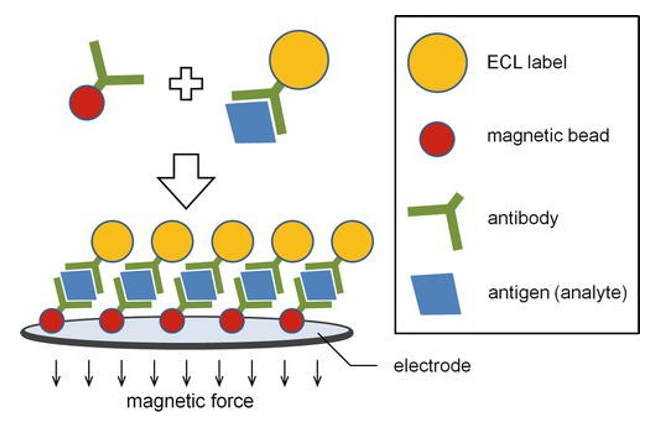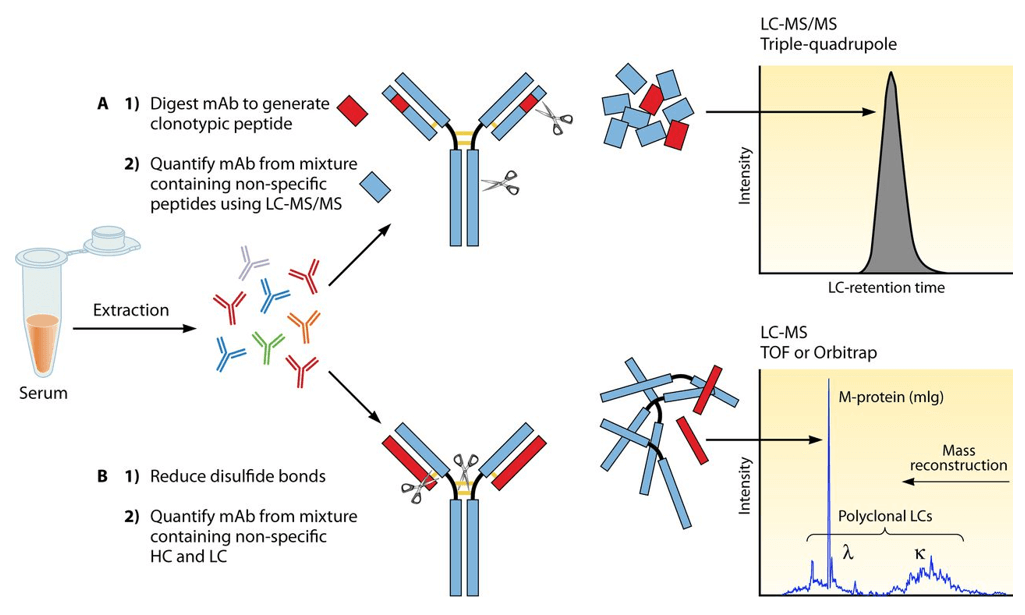Antibody drugs are characterized by their similarity to endogenous molecules, large relative molecular mass, diverse molecular types, and small doses for some. All factors contribute to the increase in the difficulty of biological analysis. Choosing an analytical method with strong specificity and high sensitivity is the key to biological sample analysis.
At present, the commonly used methods to analyze monoclonal antibody drugs include immunoassay, electrochemiluminescence (ECL) technology, and liquid chromatography-mass spectrometry (LC-MS/MS). Immunoassay is the mainstream method with its sensitivity reaching the ng level. LC-MS/MS can successfully separate samples and their metabolites and perform qualitative and quantitative analysis at the same time. It has been widely used in the pharmacokinetic research of monoclonal antibodies.
Immunoassay
Immunoassay is advantageous in detecting monoclonal antibodies. It can determine the content of the substance to be measured in the sample as an antigen or antibody, including enzyme-linked immunosorbent assay (ELISA), radioimmunoassay (RIA), immunoradiation assay (IRMA), etc.
ELISA is the most commonly used immunoassay. It uses enzyme-labeled antigen or enzyme-labeled antibody as the main reagent, and is a qualitatively or quantitatively labeled immunoassay technology by catalyzing the color of the substrate in the complex. ELISA has high sensitivity, strong specificity, high throughput, good repeatability, long reagent life, no isotope, no radiation source, is easy to operate, fast, and suitable for batch processing. However, ELISA also has some shortcomings, such as limited dynamic range, inability to simultaneously determine biotech drugs and their metabolites, susceptibility to interference from endogenous and exogenous substances, and high dependence on high-quality monoclonal antibody reagents with high specificity and strong affinity.
Electrochemiluminescence (ECL) technology based on MSD technology
The ECL technology specifically binds an antigen to an antibody labeled with an electrochemiluminescent agent, terpyridine ruthenium, and quantitatively analyzes the analyte based on the luminescence intensity on the electrode. Compared with a typical ELISA, its linear range has been expanded by more than 1,000 times, and the sensitivity has been increased by 100 times, providing a better choice for the determination of low-dose protein concentrations to be tested in some disease samples. But there is not much improvement in throughput and workflow. Therefore, if the budget allows, the ECL method can provide an alternative method for ELISA with high sensitivity, repeatability, homology and serum tolerance.

Electrochemiluminescence (Kreysa et al.,2014)
Liquid chromatography-mass spectrometry (LC-MS/MS)
LC-MS/MS is gradually becoming the main analytical method for the pharmacokinetic research of antibody drugs with its high separation, high specificity, and accurate quantification. Compared with traditional immunology, LC-MS/MS shows great advantages in terms of accuracy, reproducibility and quantitative dynamic range, as well as the ability to qualitatively and quantitatively measure the compounds simultaneously.

LC-MS/MS for quantitation of therapeutic MAbs (Ladwig et al., 2017)
References
- Kreysa, G., Ota, K., & Savinell, R. F. (Eds.). (2014). Encyclopedia of Applied Electrochemistry. doi:10.1007/978-1-4419-6996-5.
- Ladwig, P. M., Barnidge, D. R., & Willrich, M. A. V. (2017). Mass Spectrometry Approaches for Identification and Quantitation of Therapeutic Monoclonal Antibodies in the Clinical Laboratory. Clinical and Vaccine Immunology, 24(5). doi:10.1128/cvi.00545-16.






